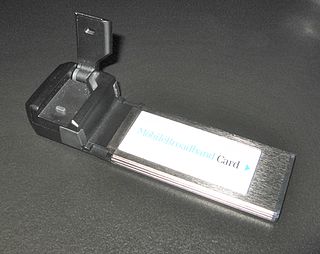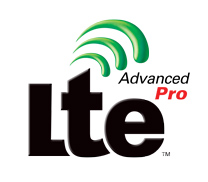The Universal Mobile Telecommunications System (UMTS) is a third generation mobile cellular system for networks based on the GSM standard. Developed and maintained by the 3GPP, UMTS is a component of the International Telecommunication Union IMT-2000 standard set and compares with the CDMA2000 standard set for networks based on the competing cdmaOne technology. UMTS uses wideband code-division multiple access (W-CDMA) radio access technology to offer greater spectral efficiency and bandwidth to mobile network operators.

3G is the third generation of wireless mobile telecommunications technology. It is the upgrade over 2G, 2.5G, GPRS and 2.75G Enhanced Data Rates for GSM Evolution networks, offering faster data transfer, and better voice quality. This network was superseded by 4G, and later on by 5G. This network is based on a set of standards used for mobile devices and mobile telecommunications use services and networks that comply with the International Mobile Telecommunications-2000 (IMT-2000) specifications by the International Telecommunication Union. 3G finds application in wireless voice telephony, mobile Internet access, fixed wireless Internet access, video calls and mobile TV.

The 3rd Generation Partnership Project (3GPP) is an umbrella term for a number of standards organizations which develop protocols for mobile telecommunications. Its best known work is the development and maintenance of:
4G is the fourth generation of broadband cellular network technology, succeeding 3G and preceding 5G. A 4G system must provide capabilities defined by ITU in IMT Advanced. Potential and current applications include amended mobile web access, IP telephony, gaming services, high-definition mobile TV, video conferencing, and 3D television.
Multimedia Broadcast Multicast Services (MBMS) is a point-to-multipoint interface specification for existing 3GPP cellular networks, which is designed to provide efficient delivery of broadcast and multicast services, both within a cell as well as within the core network. For broadcast transmission across multiple cells, it defines transmission via single-frequency network configurations. The specification is referred to as Evolved Multimedia Broadcast Multicast Services (eMBMS) when transmissions are delivered through an LTE network. eMBMS is also known as LTE Broadcast.

E-UTRA is the air interface of 3rd Generation Partnership Project (3GPP) Long Term Evolution (LTE) upgrade path for mobile networks. It is an acronym for Evolved UMTS Terrestrial Radio Access, also known as the Evolved Universal Terrestrial Radio Access in early drafts of the 3GPP LTE specification. E-UTRAN is the combination of E-UTRA, user equipment (UE), and a Node B.

Mobile broadband is the marketing term for wireless Internet access via mobile networks. Access to the network can be made through a portable modem, wireless modem, or a tablet/smartphone or other mobile device. The first wireless Internet access became available in 1991 as part of the second generation (2G) of mobile phone technology. Higher speeds became available in 2001 and 2006 as part of the third (3G) and fourth (4G) generations. In 2011, 90% of the world's population lived in areas with 2G coverage, while 45% lived in areas with 2G and 3G coverage. Mobile broadband uses the spectrum of 225 MHz to 3700 MHz.
The UMTS frequency bands are radio frequencies used by third generation (3G) wireless Universal Mobile Telecommunications System networks. They were allocated by delegates to the World Administrative Radio Conference (WARC-92) held in Málaga-Torremolinos, Spain between 3 February 1992 and 3 March 1992. Resolution 212 (Rev.WRC-97), adopted at the World Radiocommunication Conference held in Geneva, Switzerland in 1997, endorsed the bands specifically for the International Mobile Telecommunications-2000 (IMT-2000) specification by referring to S5.388, which states "The bands 1,885-2,025 MHz and 2,110-2,200 MHz are intended for use, on a worldwide basis, by administrations wishing to implement International Mobile Telecommunications 2000 (IMT-2000). Such use does not preclude the use of these bands by other services to which they are allocated. The bands should be made available for IMT-2000 in accordance with Resolution 212 ." To accommodate the reality that these initially defined bands were already in use in various regions of the world, the initial allocation has been amended multiple times to include other radio frequency bands.

Evolved High Speed Packet Access, HSPA+, HSPA (Plus) or HSPAP, is a technical standard for wireless broadband telecommunication. It is the second phase of HSPA which has been introduced in 3GPP release 7 and being further improved in later 3GPP releases. HSPA+ can achieve data rates of up to 42.2 Mbit/s. It introduces antenna array technologies such as beamforming and multiple-input multiple-output communications (MIMO). Beam forming focuses the transmitted power of an antenna in a beam towards the user's direction. MIMO uses multiple antennas at the sending and receiving side. Further releases of the standard have introduced dual carrier operation, i.e. the simultaneous use of two 5 MHz carriers. HSPA+ is an evolution of HSPA that upgrades the existing 3G network and provides a method for telecom operators to migrate towards 4G speeds that are more comparable to the initially available speeds of newer LTE networks without deploying a new radio interface. HSPA+ should not be confused with LTE though, which uses an air interface based on orthogonal frequency-division modulation and multiple access.
In telecommunications, long-term evolution (LTE) is a standard for wireless broadband communication for mobile devices and data terminals, based on the GSM/EDGE and UMTS/HSPA standards. It improves on those standards' capacity and speed by using a different radio interface and core network improvements. LTE is the upgrade path for carriers with both GSM/UMTS networks and CDMA2000 networks. Because LTE frequencies and bands differ from country to country, only multi-band phones can use LTE in all countries where it is supported.
International Mobile Telecommunications-Advanced are the requirements issued by the ITU Radiocommunication Sector (ITU-R) of the International Telecommunication Union (ITU) in 2008 for what is marketed as 4G mobile phone and Internet access service.

In telecommunications, 5G is the fifth-generation technology standard for cellular networks, which cellular phone companies began deploying worldwide in 2019, and is the successor to 4G technology that provides connectivity to most current mobile phones.
Sony Semiconductor Israel Ltd., formerly known as Altair Semiconductor, is an Israeli developer of high performance single-mode Long Term Evolution (LTE) chipsets. The company's product portfolio includes baseband processors, RF transceivers and a range of reference hardware products. Founded in 2005, Altair employs 190 employees in its Hod Hasharon, Israel headquarters and R&D center, and has regional offices in the United States, Japan, China, India, Finland, and France. Altair Semiconductor was the first chipset vendor to receive certification from Verizon Wireless to run on its 4G LTE network. Altair has also powered several devices launched on Verizon's network including the Ellipsis 7 tablet and HP Chromebook 11.6"LTE. In January 2016, it was announced that Sony was acquiring Altair for $212 Million. Altair was renamed Sony Semiconductor Israel on March 29, 2020.
The Asia-Pacific Telecommunity (APT) band plan is a type of segmentation of the 612–806 MHz band formalized by the APT in 2022–2023 and 2008-2010 respectively and specially configured for the deployment of mobile broadband technologies. This segmentation exists in two variants, FDD and TDD, that have been standardized by the 3rd Generation Partnership Project (3GPP) and recommended by the International Telecommunication Union (ITU) as segmentations A5 and A6, respectively. The APT band plan has been designed to enable the most efficient use of available spectrum. Therefore, this plan divides the band into contiguous blocks of frequencies that are as large as possible taking account of the need to avoid interference with services in other frequency bands. As the result, the TDD option includes 100 MHz of continuous spectrum, while the FDD option comprises two large blocks, one of 45 MHz for uplink transmission in the lower part of the band and the other also of 45 MHz for downlink transmission in the upper part. As defined in the standard, both FDD and TDD schemes for the 700 MHz band include guard bands of 5 MHz and 3 MHz at their lower and upper edges, respectively. The FDD version also includes a centre gap of 10 MHz. The guard bands serve the purpose of mitigating interference with adjacent bands while the FDD centre gap is required to avoid interference between uplink and downlink transmissions. The two arrangements are shown graphically in figures 1 and 2.
International Mobile Telecommunications-2020 are the requirements issued by the ITU Radiocommunication Sector (ITU-R) of the International Telecommunication Union (ITU) in 2015 for 5G networks, devices and services.
In wireless communication, carrier aggregation is a technique used to increase the data rate per user, whereby multiple frequency blocks are assigned to the same user. The maximum possible data rate per user is increased the more frequency blocks are assigned to a user. The sum data rate of a cell is increased as well because of a better resource utilization. In addition, load balancing is possible with carrier aggregation. Channel selection schemes for CA systems taking into account the optimal values for the training length and power, the number of the probed sub-channels and the feedback threshold such that the sum rate is also important for optimal achievable capacity.
5G NR is a radio access technology (RAT) developed by the 3rd Generation Partnership Project (3GPP) for the 5G mobile network. It was designed to be the global standard for the air interface of 5G networks. It is based on orthogonal frequency-division multiplexing (OFDM), as is the 4G long-term evolution (LTE) standard.
The Intel XMM modems are a series of 4G LTE, LTE Advanced, LTE Advanced Pro and 5G modems found in many phones, tablets, laptops and wearables developed by Intel Mobile Communications. Intel Mobile Communications was formed after Intel acquired the Wireless Solutions (WLS) division of Infineon early in 2011 for US$1.4 billion.










